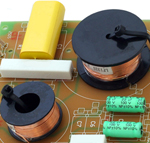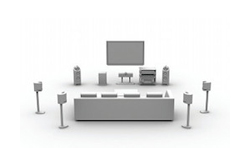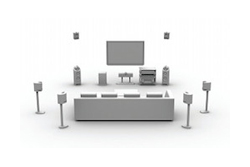Question:
I’ve seen new receivers that are advertised at 11.2. What are the additional channels used for and are they discrete channels or matrixed?
– Chris B
Oklahoma City, OK
Answer:
You ask a very good question. In order to answer your question fully, it is first useful to define “discrete” channels versus “matrix” channels. The latter has nothing to do with the futuristic trilogy starring Keanu Reeves (which coincidentally has GREAT surround sound encoding), but rather the way the audio channels are encoded.
“Discrete” channels are ones that carry fully unique and independent audio signals. The most common example of this is stereo, where the right and left channels carry independent signals so you can identify, say, a drum beat, as coming from the right or the left side.
“Matrix” channels are a blend, or matrix, embedded in two discrete audio channels. The recording/mastering studio blends the third and fourth channels in the original two discrete channels, and the matrixed channels are extracted during the decoding process to end up with four channels.
The nomenclature for surround sound can be confusing to the uninitiated, but is fairly simple in concept. The audio channels are displayed as a numbers, usually in an “X.Y” format. The “X” is the number of full range (or mostly full range) audio channels; the “Y” is the number of low frequency effect channels (think subwoofers). So a 5.1 surround sound signal would have information for five full channels (FR, FL, C, SR, SL) and one low frequency effects channel (LFE). Because the LFE carries the burden of bass from all (or mostly all) of the other channels in the setup, there is almost no real “localizable” sound. So to make a “X.2” signal, the second LFE signal is simply a duplicate of the first.
There are two major companies who encode surround sound for home theater. One is Dolby and the other DTS. Think “Coke vs Pepsi” or “Mac vs PC” and you will have some idea of what we are talking about. Both produce a myriad of surround formats, and a myriad of ways to produce each of them. Going into detail about all of them is far beyond the scope of this QA, but I will try to touch on the more familiar formats here, so when you see “Dolby ProLogic II” or “DTS-HD” on home theater electronics, you will have an idea of what that actually means.
5.1
This is the surround format we are probably the most familiar with in terms of watching movies in our home theaters. Both Dolby and DTS offer all 5.1 channels as discrete, and are simply “Dolby Digital” and “DTS”. There are also versions from each firm that can matrix 5.1 from stereo encoding. These are “Dolby ProLogic II” and “DTS Neo:6”. This speaker arrangement consists of:
Front right (FR)
Front left (FL)
Center (C)
Surround right (SR)
Surround left (SL)
Low frequency channel (LFC)
7.1
Now we arrive at the next step up from 5.1 surround sound. This adds discrete surround back right (SBR) and discrete surround back left (SBL) channels to the traditional 5.1 makeup. These additional channels are placed further back than the SR or SL, on the rear wall, about 2/3 the way from the center to the right and left corners respectively. These additional channels make for a smoother, more realistic transition as sound moves around the listener.
Both Dolby and DTS have formats that incorporate eight channels of discrete audio. There are, however, two flavors of discrete 7.1 from each: one lossy and the other lossless. Dolby calls it’s standard 7.1 encoding “Dolby Digital Plus” and the lossless version “Dolby True HD”; DTS has “DTS-HD” and “DTS-HD Master Audio”, respectively. Both the “Dolby True HD” and “DTS-HD Master Audio” formats are bit-for-bit, uncompressed copies of the original studio masters. Dolby also offers a matrix 7.1 format, “Dolby ProLogic IIx”. Most Blu-ray movies are in 5.1, while perhaps 5% are in 7.1.
Front right (FR)
Front left (FL)
Center (C)
Surround right (SR)
Surround left (SL)
Surround back right (SBR)
Surround back left (SBL)
Low frequency channel (LFC)
9.1
At this point, we have ventured off the discrete sound map, and trust me, it is easy to get lost in here! The 9.1 format adds matrix channels to 7.1 formats as front right and front left effect speakers. To add to the already dizzying array of choices, these channels can be used as either height or width effect speakers rendering front right height (FRH) and front left height (FLH), or front right width (FRW) or front left width (FLW). When used for height effect, the speakers are generally mounted on the wall above the FR and FL channels at about a 45 degree incline from the listener. When used for width effect, the speakers are mounted on the side walls, preferably half way between your center channel and the SR and SL at roughly ear level.
“Dolby ProLogic IIz” and “DTS Neo:X” are the choices here.
Front right (FR)
Front left (FL)
Front right height (FRH) or Front right width (FRW)
Front left height (FLH) or Front left width (FLW)
Center (C)
Surround right (SR)
Surround left (SL)
Surround back right (SBR)
Surround back left (SBL)
Low frequency channel (LFC)
11.1
This format adds the right and left effect speakers (height or width) that were not included in the 9.1 setup. “DTS Neo:X” is currently the only encoding format I am aware of that can even generate 11.1 sound. Now we have, in all it’s splendor:
Front right (FR)
Front left (FL)
Front right height (FRH)
Front right width (FRW)
Front left height (FLH)
Front left width (FLW)
Center (C)
Surround right (SR)
Surround left (SL)
Surround back right (SBR)
Surround back left (SBL)
Low frequency channel (LFC)
The speaker placements and order of addition I have mentioned above are not meant to be absolutes, but rather to give you a fairly good idea of the optimal speaker placement. In fact, Audyssey, who designed the room acoustic correction software found in many home theater receivers, would rather you add FRW and FLW before FRH and FLH, and all of those before you add in the more common SBR and SBL!
So here we arrive at the sad truth. There is no fully discrete 11.2 format. You can only remain discrete up to 7.1; past that however, you must succumb to the matrix! Both Dolby True HD and DTS-HD Master Audio 7.1 formats can be matrixed into any number of channels by your processor or receiver, limited only by your space and budget. As mentioned earlier, the only studio format that gets close (to my knowledge) is “DTS Neo:X”, which can matrix an 11.1 sound from 5.1, 6.1, or 7.1 channel material. Since 11.1 and 11.2 is essentially the same, with only the low frequency channel repeated, looking for a receiver with “DTS Neo:X” is likely your best bet for now.
On a side note, it must have aggravated Dolby to no end that DTS was first to the 11.1 table. In response (or at least it makes for a better story this way), Dolby has gone completely over the top and recently introduced a 62.2 surround format dubbed “Atmos”. This is only available in ~300 commercial theaters, and involve a lot more power amplifiers and speakers, so I don’t expect to see any “Atmos” receivers on retail shelves in the forseeable future.
– Robert Ebeling, III





